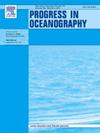Biogeochemical features along the northern and central Patagonian shelf during a spring cruise: implications for biological productivity
IF 3.6
3区 地球科学
Q1 OCEANOGRAPHY
引用次数: 0
Abstract
The Patagonian fjords, channels, and glacial meltwater plays a key role in shaping the hydrography and biogeochemistry of the Southeastern Pacific Ocean, through substantial exchanges with open ocean waters. However, the continental shelf between 46°S and 48°S remains less explored, leaving critical gaps in our understanding of nutrient dynamics and productivity patterns. This study investigates latitudinal gradients in water column biogeochemistry and productivity in northern and central Chilean Patagonia during the austral spring of 2018. We identified three distinct zones: a northern area (41°S and 46°S) with higher temperature, salinity, dissolved oxygen, and chlorophyll-a concentrations; an exchange zone between Guafo entrance and Moraleda Channel, characterized by elevated inorganic nutrient concentrations; and a southern area (46°S and 48°S) with increased ammonium concentrations and the lowest silicic acid levels. Offshore stations in the northern area exhibited the highest integrated primary production rates (up to 6.3 g C m−2 d−1), primarily sustained by nitrate uptake (ƒ ratios up to 0.98). In contrast, the southern area showed a preference for ammonium assimilation, with lower ƒ ratios (0.1–0.3). These findings suggest that the northern area supports a high proportion of new primary production, which likely enhances organic matter export and the efficiency of the biological pump, whereas regenerated production in the southern area may limit carbon export potential. Our study provides the first large-scale description of the biogeochemical features of the Patagonian continental shelf, particularly around the Taitao Peninsula, offering a critical baseline for understanding biogeochemical processes in this region and its potential responses to climate change and anthropogenic pressure.
生物地球化学特征沿北部和中部巴塔哥尼亚大陆架在春季巡航:对生物生产力的影响
巴塔哥尼亚峡湾、水道和冰川融水通过与开放海水的大量交换,在塑造东南太平洋的水文和生物地球化学方面起着关键作用。然而,46°S和48°S之间的大陆架仍然很少被探索,这给我们对营养动态和生产力模式的理解留下了重大空白。本研究调查了2018年南部春季智利巴塔哥尼亚北部和中部水柱生物地球化学和生产力的纬度梯度。我们确定了三个不同的区域:北部地区(41°S和46°S)具有较高的温度、盐度、溶解氧和叶绿素-a浓度;瓜福入口和莫拉莱达海峡之间的交换带,其特征是无机营养物质浓度升高;南部地区(46°S和48°S)铵盐浓度升高,硅酸含量最低。北部地区的海上站显示出最高的综合初级产量(高达6.3 g C m - 2 d - 1),主要由硝酸盐吸收维持(系数高达0.98)。南部地区则表现出较低的同化系数(0.1 ~ 0.3),更倾向于铵态同化。这些发现表明,北部地区支持高比例的新初级生产,这可能会增加有机质出口和生物泵的效率,而南部地区的再生生产可能会限制碳出口潜力。我们的研究首次大规模描述了巴塔哥尼亚大陆架,特别是太涛半岛周围的生物地球化学特征,为了解该地区的生物地球化学过程及其对气候变化和人为压力的潜在响应提供了关键的基线。
本文章由计算机程序翻译,如有差异,请以英文原文为准。
求助全文
约1分钟内获得全文
求助全文
来源期刊

Progress in Oceanography
地学-海洋学
CiteScore
7.20
自引率
4.90%
发文量
138
审稿时长
3 months
期刊介绍:
Progress in Oceanography publishes the longer, more comprehensive papers that most oceanographers feel are necessary, on occasion, to do justice to their work. Contributions are generally either a review of an aspect of oceanography or a treatise on an expanding oceanographic subject. The articles cover the entire spectrum of disciplines within the science of oceanography. Occasionally volumes are devoted to collections of papers and conference proceedings of exceptional interest. Essential reading for all oceanographers.
 求助内容:
求助内容: 应助结果提醒方式:
应助结果提醒方式:


